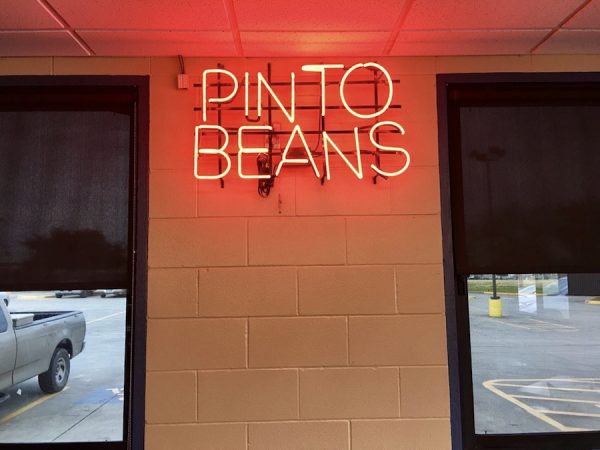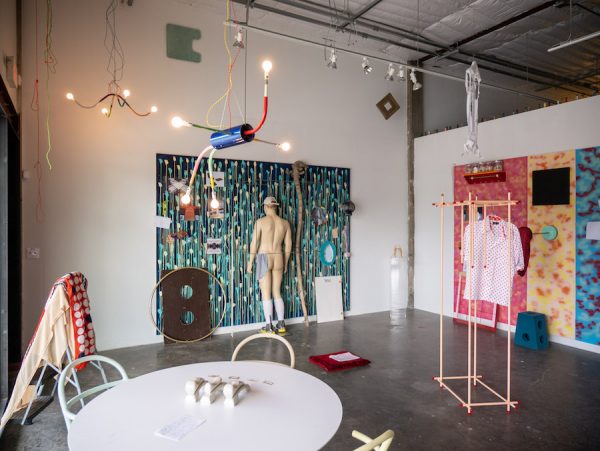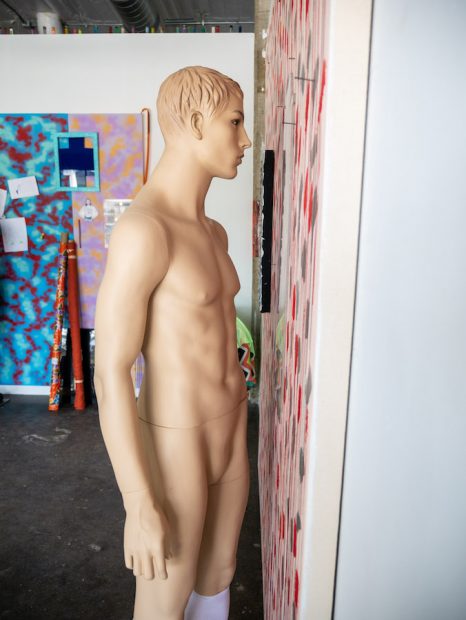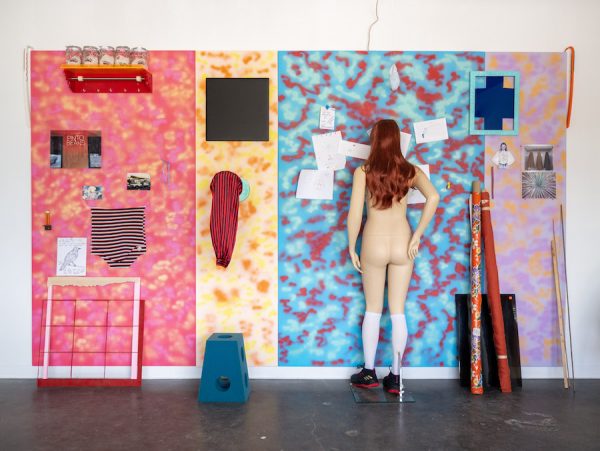
Austin-based multimedia artist Andy Coolquitt’s exhibition PINTO BEANS is on view at Bale Creek Allen Gallery in Austin until October 14.
The show packs a punch, displaying three mock studio walls, countless found objects, and fabrics galore — all scattered with handwritten notes by the artist and recycled lighters lining the tops of the gallery walls. With so much intrigue bursting from a 19 x 19-foot space, the exhibition almost feels like a fun house, with something new to discover in every corner.
I caught up with Coolquitt via email to discuss some of his inspirations for the show, and to flesh out some of the aesthetic details present in the exhibition.

Mary K. Cantrell: Can you tell me about the origins and inspirations for this show?
Andy Coolquitt: This installation grows out of: 1) the multiple “studio exhibitions” from 2002-2007; 2) the entire Artpace project; and 3) the “re-creation” of my studio/house in Sheboygan, Wisconsin. All dealing with the relationship between what happens in the studio and what happens in the exhibition. All attempts to create a scenario of pure process within a framework of fiction.
There are two specifics at play. The first being the context of Bale’s gallery. It functions as an extension of his studio practice, and is located within a large complex of artists’ studios. Its storefront is designed to signify a publicness that encourages engagement with the studio on a meta level. Bale’s program of invited artists adds context to his studio practice. Secondly, the flats — or we can call them portable studio walls — developed out of the “insane camo closet” from the Sheboygan project. The faux painted camo design came about as an accident/collaboration with the prep staff at the Kohler Museum in Sheboygan. They are constructed differently than Sheboygan because they were designed from the start to be portable. They are more like theater flats. Two repeat the camo motif, and the third was inspired by a form of public painting resulting in the attempt to conceal graffiti.
MKC: Bale told me you were deciding between just showing the portable studio walls versus creating more of an “installation” — what were your reasons behind the ultimate choice to add more objects?
AC: When just the three panel works were installed it felt too decisive, and they clearly read as discrete paintings, which I was skeptical of. There is always a conversation between how discrete objects function within a crowded room, and how they function within a sparse room. Since most of the rooms in normal daily life are a bit crowded, I tend to lean that way when I design an exhibition — both to subvert the default theatrical nature of the white cube, and to manipulate the viewer’s body as it flows through a room.

MKC: When I think of the themes you are working with — surveillance and private thoughts — technology is an inevitable link. But the aesthetics of found, almost seemingly meaningless objects aren’t the traditional tactics used to encourage audiences to think about those topics. What about these materials makes you think of public display/surveillance/etc.?
AC: I’m not sure if I’m interested in encouraging the viewer to think about surveillance. It’s something I think about a lot these days, but not necessarily as content for the work… it’s more of an omnipresent reality. The “found, almost seemingly meaningless objects” represent the unconscious tinkering that happens in my studio. And since this exhibition is about a play between a constructed fictional studio and a real, albeit temporary, studio, there is an attempt at being true to the unconscious gestures of daily life. The questions I’m concerned with have to do with how the surveillance alters our notion of unconscious or private thoughts. How we are responding to being under constant surveillance… if we are subconsciously constructing coded secret language to counter this reality.
MKC: Do you think audiences are more intrigued by objects they recognize, or objects that are foreign to them? In a way, do your studio walls combine a bunch of familiar objects to create one unrecognizable one?
AC: I don’t know, that’s a big question. Personally, I lean towards recognizable things, and typically very banal things. I love how everyone brings different narratives to recognizable things. Maybe I look for the foreign qualities of recognizable things? Or I try to slow down and look at normal things more closely? I love the idea of realizing some tiny spark of magic in the most banal thing. And I love it more when I’m not sure if it even exists, when it teeters back and forth between something and nothing.

MKC: Can you talk a little bit about the role of the still photographs in the installation?
AC: Yes. I think the images have been an important part of my practice ever since the first small digital cameras came out, before phone cameras. (I’m not the kind of person that walks around with a professional camera.) So when we switched from getting everything printed to going digital, I started taking many more pictures. And this allows many more images to enter into the conversation. I want to include them all! And now I love to get these big cheap prints and make objects with the images. They get taped to leftover pieces of Plex, and for some reason I thought it was important that they hang off the wall a bit. They dangle on the two nails and air goes behind them.
MKC: One of the focal points of the show is the bird drawing I Do Not Sing My Song. Can you discuss that drawing a bit more? Maybe why you chose to place it where you did?
AC: It is a drawing by David Shrigley. He posted it the same afternoon I was writing about creating a secret language to counter surveillance, so it was one of those creepy internet moments. I printed it and taped it to a chunk of Plex like the other printed photos. I didn’t think much about where to put it, and since the Plex didn’t already have holes, I propped it on the nearest ledge.
MKC: What make you decide to title the show PINTO BEANS, after the neon sign photo?
AC: I have no idea … it makes me hungry? I like the idea that they are marketing the lowly pinto bean in such a glorious fashion. I like the fire-hot color … I like ALL CAPS.

MCK: Is there a reason the mannequins are naked except for tall socks and tennis shoes?
AC: There probably is a reason other than simple laziness on my part. I broke the fuck out of my leg last year, and now I wear compression socks for life. The Adidas Crazylights also have a sort of built-in sock. For some reason I have been referring to them as figures, rather than mannequins. Like, we wanna say figurative painting, not mannequin painting, right?
Here’s a fun fact: They are all looking very closely at something, but what I didn’t notice until a few days ago — a week after the opening — is that they are all playing their familial roles quite interestingly. The BOY is looking at a reflection of himself. DADDY is inspecting the quality of the gap between two panels. And MOMMY is reading the personal notes.

MKC: One of my favorite pieces is the willow tree-esque sculpture in the corner with the purple fuzzy toilet seat mat. It made me chuckle. What’s the role of humor in your work? Do you aim to juxtapose serious questions with humorous objects/placements/groupings?
AC: That sculpture, if you can call it a sculpture, is part of “the stuff” that is sitting around in my studio. I can start by saying that the stuff represents unconscious thought. The stuff is the result of mindless tinkering that honestly takes up most of my “studio practice.” Notes scribbled on paper, cheap prints from point-and-shoot phone-camera photography, clunky constructions of fabric and wood — and in this case, a pile of fabric resting in the cradle of an Eero Saarinen tulip armchair. LOTS of my time is spent going through piles of fabric. I pick it up, hold it out in front of me, think about it for a bit, then put it somewhere else. A tulip armchair can hold a pretty big pile of stuff. The one thing I did notice, when transporting it from the studio to the gallery, was that the top two layers of fabric were sort of transparent, so you can see three different patterns. The purple U-shaped rug that snugs up to a toilet, known in the biz as a contour rug, was in another pile of stuff that got thrown into the van during install.
At some point along the way it found its proper place at the base of the tulip.
On view at Bale Creek Allen Gallery, Austin, through Oct. 14, 2019.


